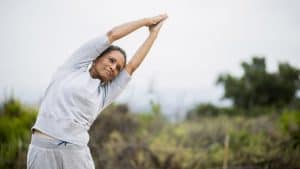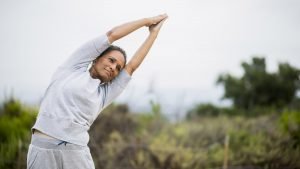
On
the list of “fun things to do,” medical tests of any kind don’t usually make
the top 10. Some, however, are notoriously worse than others.
For
example, I’d rather have my body cryogenically frozen until we have an
alternative to colonoscopies than to go through the prep for another one.
Bone
mineral scans (a DXA test), on the other hand, are painless, require no nasty
tasting gallon of prep to choke down – and
don’t require prancing around in a fashionable backless paper gown.
So,
when I went into my first DXA scan 10 years ago at age 50, I was in a better
mood than usual for a medical appointment.
Unexpected
Diagnosis
I
joked and chatted with the technician as she set me up on the scanner. “After all
these years of weight training my bones must be stronger than giant redwoods,”
I said, positive I’d be one of their shining examples of good health and strong
bones.
She
laughingly agreed.
Her
chuckles came to an abrupt halt as my test results popped up across her screen.
Her
sudden silence was in such contrast to our initial festive mood, I asked the
obvious question, “Well… what do you see?”
Normally,
technicians tell you to wait for the doctor to explain test results, but she
broke protocol and told me outright, “You have osteoporosis.” Not only that,
but it was severe.
To
give you an idea of how severe… a DXA scan gives a T-score, which measures the
normal bone mineral density against that of a healthy young adult and is
measured in standard deviations.
A
score of 0 is the norm and scores below 0 indicate progressively lower and
lower bone mass. A T-score of -2.5 or lower indicates osteoporosis.
My
T-score was -3.6.
Wait,
what??? How can that be?
I’ve
been lifting weights since the dawn of time, take vitamin D, and eat tons of
yogurt shouldn’t that be enough to keep my bones healthy as the proverbial
oxen?
My Youth Years Came
Haunting
The
short answer: Nope.
The
long answer: Not if you had an eating disorder in your teens when your bones
were still developing.
Bingo.
I was
anorexic in my late teens, starving myself of the necessary nutrition required
to build healthy bones.
By
the time I came out of that self-destructive haze (which took many years), the
damage was done.
In
short, my hips and spine are as fragile as a house of cards in an F5
tornado.
Since
my diagnosis, I’ve spoken to many bone experts, have been on several regimens,
and I go to a specialist every two years to check my progress.
“You
will never not have osteoporosis,” my doctor tells me. “The best we can
do is stop it from getting worse.”
The
bad news: No amount of weight-lifting can reverse osteoporosis.
The
good news: Some exercises can improve or maintain bone density. Others may put
someone with osteoporosis at a higher risk of fractures.
Problem
is, guidelines for exercising when you have osteoporosis are not crystal
clear.
However,
several general rules can help you stay safe as you get fit.
Learn Perfect Form
and Use Good Posture When Working Out
Lifting
even light weights with poor posture can be dangerous for someone with
osteoporosis. Your back can tolerate more when you work out with perfect
posture than if you lift with a rounded back something you should never do.
Start Easy
Depending
on the degree of osteoporosis and baseline activity level, start out with
low-impact exercise, like using an elliptical. Then, if your physician
approves, you can advance to higher levels of impact, such as jogging or
aerobics classes.
Know the Safe Pilates
and Yoga Exercises
Exercises
that require you to use a rounded back increase the risk of fractures along the
spine and should be avoided. This includes certain yoga and Pilates poses that
create compression between the vertebrae. Tell your instructor your limitations,
and they’ll provide recommendations to keep you safe.
Examples
of Pilates exercises to avoid include (see a complete list on the NOF.org website):
Hundred,
Rollup, Rolling, Crisscross, Teaser, Single/Double Leg Stretch, Neck Pull, Open
Leg Rocker, Rollover, Corkscrew, Bicycle, Boomerang, Seal, Crab, Control
Balance, Spine Twist, and others.
Safe
Pilates moves: Core control, dynamic alignment such as planks and side planks,
leg strength and spinal extensions, such as cobra.
Yoga
exercises to avoid: Rounding poses, deep twists, deep hip stretch such as
Pigeon Pose and warrior – as
well as assisted stretching from teachers to increase range of motion.
Safe yoga poses: Balance exercises such as tree pose, dynamic alignment, leg strength, and spinal extension poses.
Include Resistance
Exercises
Strengthening
your muscles helps reduce fracture risk and includes lifting weights, using
elastic bands, weight machines, lifting your own body weight with exercises
such as push-ups.
Be sure to focus on functional movements, according to recommendations by the National Osteoporosis Foundation.
These
include exercises that mimic movements you use in everyday activities, such as
squats and combination exercises that involve more than one joint – squats with biceps curls,
for example.
What’s
the health status of your bones? Do you have osteopenia or osteoporosis? What
exercises work best for you? Which of these rules were most helpful? Let’s chat
below!
Disclaimer: This article is not intended to provide medical advice. Please consult with your doctor to get specific medical advice for your situation.





